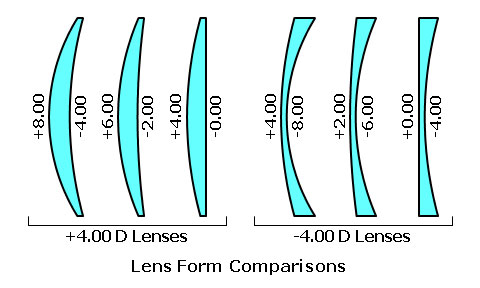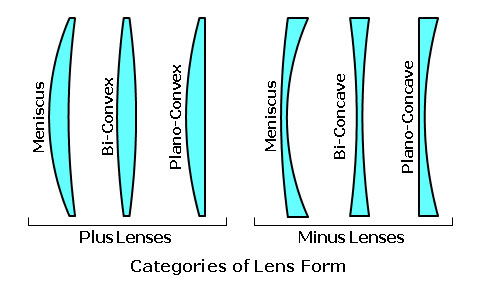The fundamental principles of ophthalmic lens design begins with understanding how power is delivered by lenses.
FOCAL POWER
The ability of a lens to refract and focus light—by either converging or diverging it—is referred to as its focal power or refractive power. The focal power of a lens is simply equal to the net effect of its front and back surfaces. When a refractionist writes a prescription for an ophthalmic lens, he/she is specifying the focal power of the lens. The focal power of a lens, in diopters, is given by:*
Where (P) is focal power in diopters, (F) is the front surface power in diopters, and (B) is the back surface power in diopters. Both focal power and surface power are measured in units called diopters (abbreviated 'D').
For example, consider a lens with a 6.00 D front curve and a -4.00 D back curve. The focal power (P) is equal to F + B = 6.00 + (-4.00) = +2.00 D.
* This is an approximation to keep our math simple; the formula becomes a bit more complex when lens thickness is considered.
LENS FORM
The relationship between the front and back surface curves of a lens is referred to as the lens form (or lens profile). A lens with a given focal power can be produced by many different lens forms, as long as the sum of the front and back surface powers remains constant—or at least nearly so (neglecting thickness). A given lens power can be produced with an almost endless variety of lens forms, as long as the sum of the front and back surface powers remains equal to the desired focal power.

Historically, spectacle lenses fall into either one of two general categories of lens form:
- Bent lenses: Modern lens form are generally bent, or meniscus—which means "crescent-shaped." Bent lenses use convex front curves and concave back curves.
- Flat lenses: The earliest lens forms were flat. For plus lenses, flat lenses use either convex curves for both the front and back (i.e., bi-convex lenses), or one convex curve and one plano (plano) curve (i.e., plano-convex lenses). For minus lenses, flat lenses use either concave curves for both the front and back (i.e., bi-concave lenses), or one concave curve and one plano (plano) curve (i.e., plano-concave lenses).














